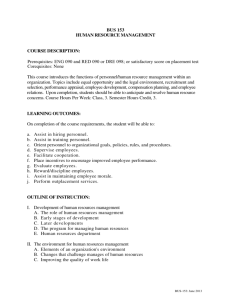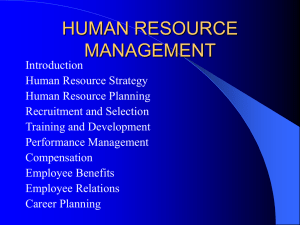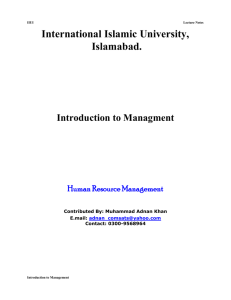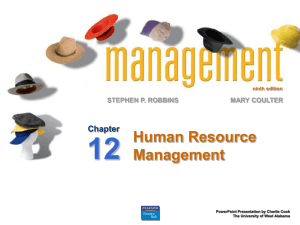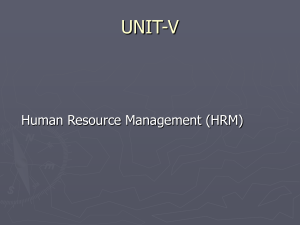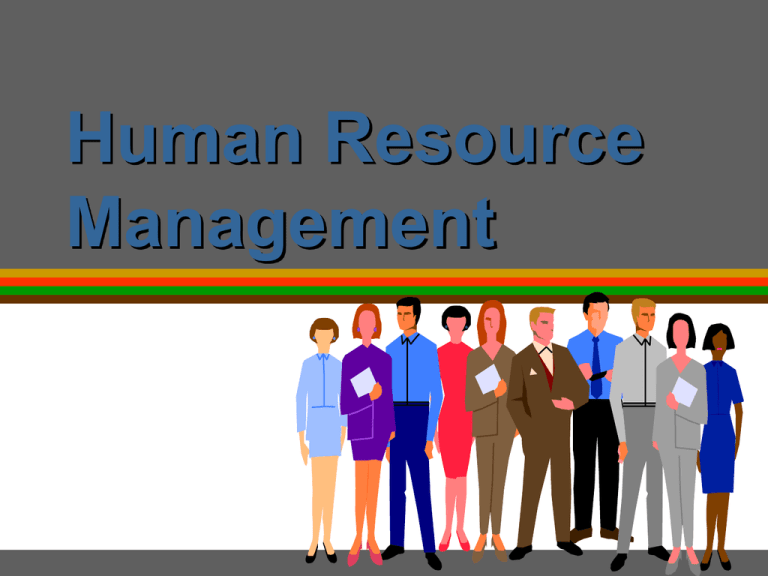
Human Resource
Management
Is there any difference between
Personnel management and Human
resource management ????
2
• For those who recognize a difference between
personnel management and human resources, the
difference can be described as philosophical.
• Personnel management is more administrative in
nature, dealing with payroll, complying with
employment law, and handling related tasks.
• Human resources, on the other hand, is responsible
for managing a workforce as one of the primary
resources that contributes to the success of an
organization.
• Human resources is described as much broader
in scope than personnel management.
• Human resources is said to incorporate and
develop personnel management tasks, while
seeking to create and develop teams of workers
for the benefit of the organization. A primary
goal of human resources is to enable employees
to work to a maximum level of efficiency
• Personnel management can include
administrative tasks that are both traditional and
routine. It can be described as reactive,
providing a response to demands and concerns
as they are presented.
• By contrast, human resources involves ongoing
strategies to manage and develop an
organization's workforce. It is proactive, as it
involves the continuous development of
functions and policies for the purposes of
improving a company's workforce.
• PM is often considered an independent function
of an organization.
• Human resource management, on the other
hand, tends to be an integral part of overall
company function.
What is Human Resource Management?
• Managing the effective use of people to achieve
both organizational and individual goals
• Ie; through the effective recruitment, selection,
development, compensation, and utilization of
human resources by organizations
In short……..HRM is the integration
(incorporation/mixing) of all processes, programs, and
systems in an organization that ensure staff are acquired
and used in an effective way
Human Resource Management (Contd.)
HR is multidisciplinary: It applies the disciplines of
Economics (wages, markets, resources),
Psychology (motivation, satisfaction),
Sociology (organization structure, culture) and
Law (min. wage, labor contracts)
What HR Professionals Do?
HR planning
Recruitment & Selection
Training and development
Compensation & Performance review
Labor relations
Why you care about HRM?
• Impact on employees
• Impact on managers
• Provides potential future roles as HR
professionals
• Impact on organizations
HRM has increased in importance
since the 1980s. Why?
• Globalization
• Government regulation
• Stronger knowledge/research base
• Changing role for labor unions
• Challenge of matching worker expectations with
competitive demands
What motivates you as an
employees?
•
•
•
•
•
•
•
•
Good wages
Good working conditions
Job security
Full appreciation of work that is done
Tactful disciplining
Employer loyalty to employees
Interesting work
Promotion and growth in the organization
How HR Functions Relate to HR
Activities
The Acquisition of
Human Resources
Planning
Analyzing Jobs
Recruitment
Selection
The Development of
Human Resources
Appraising
Training
Developing
How HR Functions Relate to HR
Activities, continued
The Maintenance of
Human Resources
The Rewarding of
Human Resources
Compensating
(Wages & Salaries)
(Incentives)
Employee Benefits
Safety & Health
Labor Relations
Goals of Human Resource Management
Facilitating
organizational
competitiveness
Enhancing
productivity and
quality
The human resource
function in contemporary
organizations
Complying with
legal and social
obligations
Promoting
individual growth
and development
The HRM Process
• Functions of the HRM Process
Ensuring that competent employees are identified and
selected.
Providing employees with up-to-date knowledge and
skills to do their jobs.
Ensuring that the organization retains competent and
high-performing employees who are capable of high
performance.
The Human Resource Management Process
12–18
Environmental Factors Affecting HRM
• Labor Union
An organization that represents workers and seeks to
protect their interests through collective bargaining.
• Collective Bargaining Agreement
A contractual agreement between a firm and a union
elected to represent a bargaining unit of employees of
the firm in bargaining for:
Wage,
hours, and working conditions.
Environmental Factors Affecting HRM
(cont’d)
• Affirmative Action
The requirement that organizations take proactive
steps to ensure the full participation of protected
groups in its workforce.
• Laws and Regulations
Limit managerial discretion in hiring, promoting, and
discharging employees.
Key Functions
Human Resource Planning
Recruitment & Selection
Compensation & Benefits
Performance Appraisals
Training & Development
• Human Resource (HR) Planning
The process by which managers ensure that they
have the right number and kinds of people in the right
places, and at the right times, who are capable of
effectively and efficiently performing their tasks.
Helps avoid sudden talent shortages and surpluses.
Steps in HR planning:
Assessing
current human resources
Assessing
future needs for human resources
Developing
a program to meet those future needs
Human Resource Planning
Assessing Current
Human Resources
Assessing Future
Human Resource
Needs
Developing a
Program to Meet
Needs
Current Assessment
• Human Resource Inventory
A review of the current make-up of the organization’s
current resource status
Job Analysis
An
assessment that defines a job and the behaviors
necessary to perform the job
– Knowledge, skills, and abilities (KSAs)
Requires
conducting interviews, engaging in direct
observation, and collecting the self-reports of
employees and their managers.
Tasks
Responsibilities
Duties
Human Resource
Planning
Recruitment
Selection
Training and
Development
Job
Descriptions
Job
Analysis
Performance Appraisal
Compensation and
Benefits
Job
Specifications
Safety and Health
Employee and Labor
Relations
Knowledge
Skills
Abilities
Legal Considerations
Job Analysis for Teams
Current Assessment (cont’d)
• Job Description
A written statement of what the job holder does, how
it is done, and why it is done.
• Job Specification
A written statement of the minimum qualifications that
a person must possess to perform a given job
successfully.
Definitions
Job - Consists of a group of tasks that must be
performed for an organization to achieve its goals
Position - Collection of tasks and responsibilities
performed by one person; there is a position for every
individual in an organization
Job analysis - Systematic process of determining the
skills, duties, and knowledge required for performing jobs
in an organization (functional job analysis , position
analysis questionnaire)
Job description – document providing information
regarding tasks, duties, and responsibilities of job
Job specification – minimum qualifications to perform a
particular job
Meeting Future Human Resource Needs
Supply of Employees
Demand for Employees
Factors Affecting Staffing
Strategic Goals
Forecast demand for products and services
Availability of knowledge, skills, and abilities
Major Sources of Potential Job Candidates
Recruitment
Process of locating,
identifying, and attracting
capable candidates
Can be for current or future
needs
Critical activity for some
corporations.
What sources do we use for
recruitment
Recruitment and Decruitment
• Recruitment
The process of locating, identifying, and attracting
capable applicants to an organization
• Decruitment
The process of reducing a surplus of employees in
the workforce of an organization
• E-recruiting
Recruitment of employees through the Internet
Organizational
web sites
Online recruiters
Decruitment Options
Sources of Recruitment
School
Placement
Employee
Referrals
Internal
Searches
Recruitment
Sources
Employment
Agencies
Advertisements
Voluntary
Applicants
SELECTION
A series of steps from initial applicant screening
to final hiring of the new employee.
Selection process.
Step 1 Completing application materials.
Step 2 Conducting an interview.
Step 3 Completing any necessary tests.
Step 4 Doing a background investigation.
Step 5 Deciding to hire or not to hire.
Selection process
Step 1 Completing application materials.
Gathering information regarding an applicant’s background and
experiences.
Typical application materials.
Traditional application forms.
Résumés.
Sometimes tests may be included with application materials.
Step 2 Conducting an interview.
Typically used though they are subject to perceptual distortions.
Interviews can provide rough ideas concerning the person’s fit with
the job and the organization.
Selection process
Step 3 Completing any necessary tests.
Administered before or after the interview.
Common examples of employment tests.
Cognitive, clerical, or mechanical aptitudes or abilities.
Personality.
Step 4 Doing a background investigation.
Can be used early or late in selection process.
Background investigations include:
Basic level checks.
Reference checks.
Selection process
Step 5 Deciding to hire or not to hire.
Draws on information produced in preceding selection steps.
A job offer is made.
A physical examination may be required if it is relevant to job
performance.
Negotiation of salary and/or benefits for some jobs.
Step 6 Socialization.
The final step in the staffing process.
Involves orienting new employees to:
The firm.
The work units in which they will be working.
The firm’s policies and procedures.
The firm’s organizational culture.
Types of Selection Devices
• Application Forms
• Written Tests
• Performance Simulations
• Interviews
• Background Investigations
• Physical examinations
Written Tests
• Types of Tests
Intelligence: how smart are you?
Aptitude: can you learn to do it?
Attitude: how do you feel about it?
Ability: can you do it?
Interest: do you want to do it?
• Legal Challenges to Tests
Lack of job-relatedness of test to job requirements
Discrimination in equal employment opportunity
against members of protected classes
Performance Simulation Tests
• Testing an applicant’s ability to perform actual
job behaviors, use required skills, and
demonstrate specific knowledge of the job.
Work sampling
Requiring
applicants to actually perform a task or set of
tasks that are central to successful job performance.
Assessment centers
Dedicated
facilities in which job candidates undergo a
series of performance simulation tests to evaluate their
managerial potential.
Other Selection Approaches
• Situational Interviews
Interviews in which candidates are evaluated on how
well they handle role play in mock scenarios.
• Background Investigations
Verification of application data
Reference checks:
Lack
validity because self-selection of references
ensures only positive outcomes.
• Physical Examinations
Useful for physical requirements and for insurance
purposes related to pre-existing conditions.
Suggestions for Interviewing
1. Structure a fixed set of questions for all applicants.
2. Have detailed information about the job for which applicants
are interviewing.
3. Minimize any prior knowledge of applicants’ background,
experience, interests, test scores, or other characteristics.
4. Ask behavioral questions that require applicants to give
detailed accounts of actual job behaviors.
5. Use a standardized evaluation form.
6. Take notes during the interview.
7. Avoid short interviews that encourage premature decision
making.
Other Selection Approaches (cont’d)
• Realistic Job Preview (RJP)
The process of relating to an applicant both the
positive and the negative aspects of the job.
Encourages
mismatched applicants to withdraw.
Aligns successful applicants’ expectations with actual
job conditions; reducing turnover.
Orientation
• Transitioning a new employee into the
organization.
Work-unit orientation
Familiarizes
new employee with work-unit goals
Clarifies how his or her job contributes to unit goals
Introduces he or she to his or her coworkers
Organization orientation
Informs
new employee about the organization’s
objectives, history, philosophy, procedures, and rules.
Includes a tour of the entire facility
Types of Training
• Interpersonal skills
• Technical
• Business
• Mandatory
• Performance management
• Problem solving/Decision making
• Personal
12–46
Employee Training Methods
• Traditional
Training Methods
On-the-job
Job rotation
Mentoring and coaching
Experiential exercises
Workbooks/manuals
Classroom lectures
• Technology-Based
Training Methods
CD-ROM/DVD/Videotapes/
Audiotapes
Videoconferencing/
teleconferencing/
Satellite TV
E-learning or other
interactive modules.
Performance Appraisal
Performance Appraisal
The identification, measurement,
and management of human
performance in organizations.
Why Conduct Performance Appraisals?
Make decisions about that person's future
with the organization
Identify training requirements
Employee improvement
Pay, promotion, and other personnel
decisions
Research
Validation of selection techniques and criteria
Techniques for Evaluating Managers
Evaluation by superiors
Evaluation by colleagues
Peer ratings tend to be more favorable for
career development than for promotion
decisions
Self-evaluation
Self-ratings suffer from leniency
Subordinate evaluation
Effective in developing leadership
Leads to improved performance
360 degree feedback (multi-source)
360° Feedback
The combination of peer,
subordinate, and self-review
Employee Performance Management
• Performance Management System
A process establishing performance standards and
appraising employee performance in order to arrive at
objective HR decisions and to provide documentation
in support of those decisions.
Copyright © 2005 Prentice Hall, Inc. All rights reserved.
12–53
Performance Appraisal Methods
• Written essays
• Critical incidents
• Graphic rating scales
• Behaviorally anchored rating scales (BARS)
• Multiperson comparisons
• Management By Objectives (MBO)
• 360 Degree feedback
Compensation and Benefits
• Benefits of a Fair, Effective, and Appropriate
Compensation System
Helps attract and retain high-performance employees
Impacts on the strategic performance of the firm
• Types of Compensation
Base wage or salary
Wage and salary add-ons
Incentive payments
Skill-based pay
Factors That Influence Compensation and Benefits
Career Development
• Career Defined
The sequence of positions held by a person during
his or her lifetime.
• Career Development
Provides for information, assessment, and training
Helps attract and retain highly talented people
• Boundaryless Career
A career in which individuals, not organizations,
define career progression and organizational loyalty
Some Suggestions
for a Successful
Management
Career
Contemporary HRM Issues
• Downsizing
The planned elimination of jobs in an organization
Provide
open and honest communication.
Reassure survivors.
• Managing Work Force Diversity
Recruitment for diversity
Selection without discrimination
Orientation and training that is effective
Contemporary HRM Issues (cont’d)
• Sexual Harassment
An unwanted activity of a sexual nature that affects
an individual’s employment.
Unwanted
sexual advances, requests for sexual favors,
and other verbal or physical conduct of a sexual nature
when submission or rejection of this conduct explicitly
or implicitly affects an individual’s employment.
An offensive or hostile environment
An
environment in which a person is affected by
elements of a sexual nature.
Contemporary HRM Issues (cont’d)
• Work-Life Balance
Employees have personal lives that they don’t leave
behind when they come to work.
Organizations have become more attuned to their
employees by offering family-friendly benefits:
On-site
child care
Summer day camps
Flextime
Job sharing
Leave for personal matters
Flexible job hours
Desired Outcomes of HRM
• Attraction
• Retention
• Job Performance
• Productivity
• Employee Safety and Health
• Attendance
• Job Satisfaction
• Competitive Advantage
• Company Performance

